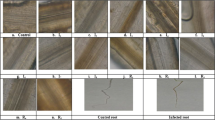Abstract
Thirty isolates of Fusarium oxysporum from wilted Welsh onion plants were examined for their diversity in nucleotide sequences of the ribosomal DNA (rDNA) intergenic spacer (IGS) region and for pathogenicity with regard to five Welsh onion cultivars. Phylogenetic analysis based on the IGS sequences revealed polyphyletic origins of the isolates and a relationship between phylogeny and pathogenicity; low virulence isolates differed genetically from those with high and moderate virulence. Mating type analysis revealed that all F. oxysporum isolates were MAT1-1 idiomorphs, suggesting that the pathogens may be clonal in the fields examined.

Similar content being viewed by others
References
Abawi GS, Lorbeer JW (1972) Several aspects of the ecology and pathology of Fusarium oxysporum f. sp. cepae. Phytopathology 62:870–876
Abo K, Klein KK, Edel-Hermann V, Gautheron N, Traore D, Steinberg C (2005) High genetic diversity among strains of Fusarium oxysporum f. sp. vasinfectum from cotton in Ivory Coast. Phytopathology 95:1391–1396
Appel DJ, Gordon TR (1996) Relationships among pathogenic and nonpathogenic isolates of Fusarium oxysporum based on the partial sequence of the intergenic spacer region of the ribosomal DNA. Mol Plant Microbe Interact 9:125–138
Arie T, Kaneko I, Yoshida T, Noguchi M, Nomura Y, Yamaguchi I (2000) Mating-type genes from asexual phytopathologenic ascomycetes Fusarium oxysporum and Alternaria alternata. Mol Plant Microbe Interact 13:1330–1339
Dissanayake MLMC, Kashima R, Tanaka S, Ito S (2009) Pathogenic variation and molecular characterization of Fusarium species isolated from wilted Welsh onion in Japan. J Gen Plant Pathol 75:37–45
Elmer WH, Covert SF, O’Donnell K (2007) Investigation of an outbreak of Fusarium foot and fruit rot of pumpkin within the United States. Plant Dis 91:1142–1146
Enya J, Togawa M, Takeuchi T, Yoshida S, Tsushima S, Arie T, Sakai T (2008) Biological and phylogenetic characterization of Fusarium oxysporum complex, which causes yellows on Brassica spp., and proposal of F. oxysporum f. sp. rapae, a novel forma specialis pathogenic on B. rapa in Japan. Phytopathology 98:475–483
Galván GA, Koning-Boucoiran CFS, Koopman WJM, Burger-Meijer K, González PH, Waalwijk C, Kik C, Scholten OE (2008) Genetic variation among Fusarium isolates from onion, and resistance to Fusarium basal rot in related Allium species. Eur J Plant Pathol 121:499–512
Hall TA (1999) BioEdit: a user-friendly biological sequence alignment editor and analysis program for Windows 95/98/NT. Nucleic Acids Symp Ser 41:95–98
Kashima R, Dissanayake C, Dogo M, Funahashi M, Shigyo M, Ito S (2007) Fusarium species isolated from bunching onion showing wilt symptoms (in Japanese). Hort Res (Japan) 6(Suppl 2):267
Kawabe M, Kobayashi Y, Okada G, Yamaguchi I, Teraoka T, Arie T (2005) Three evolutionary lineages of tomato wilt pathogen, Fusarium oxysporum f. sp. lycopersici, based on sequences of IGS, MAT1 and pg1, are each composed of isolates of a single mating type and a single or closely related vegetative compatibility group. J Gen Plant Pathol 71:263–272
Kawabe M, Katsube K, Yoshida T, Arie T, Tsuchiya K (2007) Genetic diversity of Fusarium oxysporum f.sp. spinaciae in Japan based on phylogenetic analyses of rDNA-IGS and MAT1 sequences. J Gen Plant Pathol 73:353–359
Kimura M (1980) A simple method for estimating evolutionary rates of base substitutions through comparative studies of nucleotide sequences. J Mol Evol 16:111–120
Kodama F (1977) Fusarium wilt disease of Welsh onion caused by Fusarium oxysporum (Abstract in Japanese). Ann Phytopathol Soc Jpn 43:340
Kodama F (1983) Studies on basal rot of onion caused by Fusarium oxysporum f. sp. cepae and its control (in Japanese with English summary). Rep Hokkaido Pref Agric Expt Stn 39:1–65
Komada H (1975) Development of a selective medium for quantitative isolation of Fusarium oxysporum from natural soils. Rev Plant Prot Res 8:114–125
Leslie JF, Summerell BA (2006) The Fusarium laboratory manual. Blackwell, Ames
Nelson PE, Toussoun TA, Marasas WFO (1983) Fusarium species: an illustrated manual for identification. The Pennsylvania State University Press, University Park, PA
Özer N, Köycü ND, Chilosi G, Magro P (2004) Resistance to Fusarium basal rot of onion in greenhouse and field and associated expression of antifungal compounds. Phytoparasitica 32:388–394
Saitou N, Nei M (1987) The neighbour-joining method: a new method for reconstructing phylogenetic trees. Mol Biol Evol 4:406–425
Swift CE, Wickliffe ER, Schwartz HF (2002) Vegetative compatibility groups of Fusarium oxysporum f. sp. cepae from onion in Colorado. Plant Dis 86:606–610
Takakuwa M, Ishizaka N, Kodama F, Saito I (1977) Host range of Fusarium oxysporum f. sp. cepae, causal fungus of Fusarium basal rot of onion (in Japanese with English summary). Ann Phytopathol Soc Jpn 43:479–481
Takeuchi T, Sinohara S, Nagai Y (1983) Survey on occurrence of Fusarium wilt of Welsh onion and its control. Bull Chiba Agric Exp Stn 24:1–6
Thompson JD, Gibson TJ, Plewniak F, Jeanmougin F, Higgins DG (1997) The Clustal_X windows interface: flexible strategies for multiple sequence alignment aided by quality analysis tools. Nucleic Acids Res 25:4876–4882
Yoo SJ, Wakanabe H, Kobayashi K, Ogoshi A, Kodama F (1993) Vegetative compatibility grouping of formae speciales of Fusarium oxysporum pathogenic to Liliaceae. Ann Phytopathol Soc Jpn 59:3–9
Acknowledgments
We thank Mr. Masataka Funahashi, Nissan Seed, Nishinomiya, Japan, for providing wilted Welsh onion samples. This work was supported in part by Nissan Seed Foundation.
Author information
Authors and Affiliations
Corresponding author
Rights and permissions
About this article
Cite this article
Dissanayake, M.L.M.C., Kashima, R., Tanaka, S. et al. Genetic diversity and pathogenicity of Fusarium oxysporum isolated from wilted Welsh onion in Japan. J Gen Plant Pathol 75, 125–130 (2009). https://doi.org/10.1007/s10327-009-0152-6
Received:
Accepted:
Published:
Issue Date:
DOI: https://doi.org/10.1007/s10327-009-0152-6




